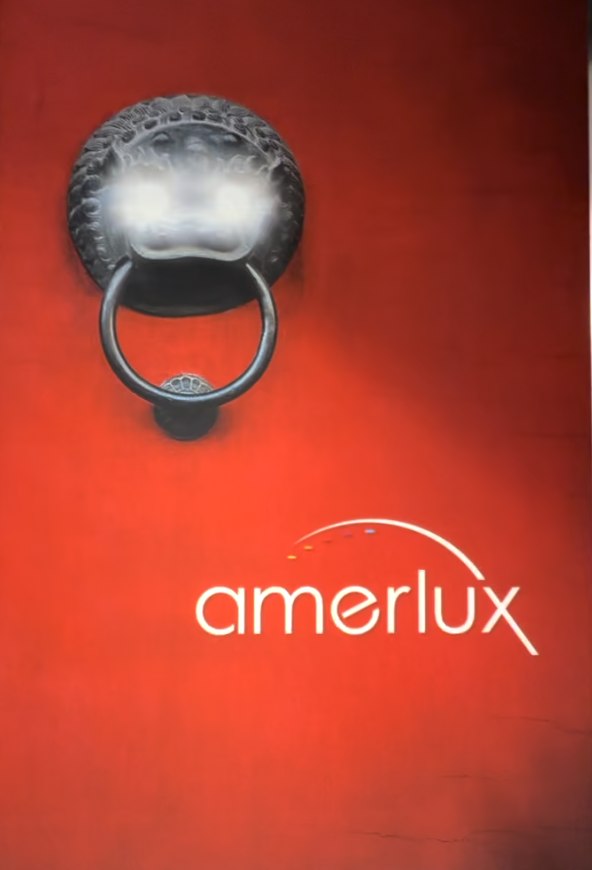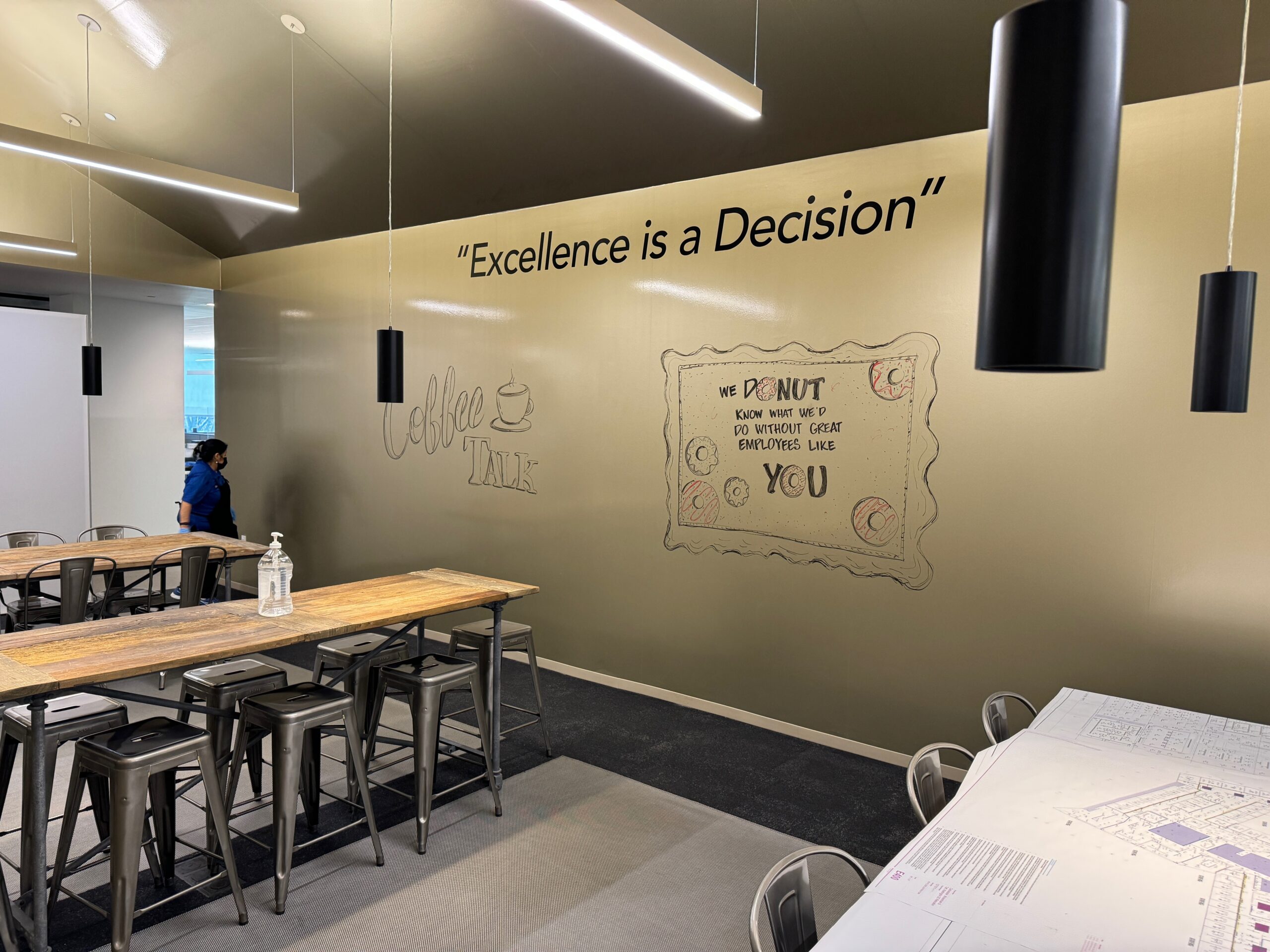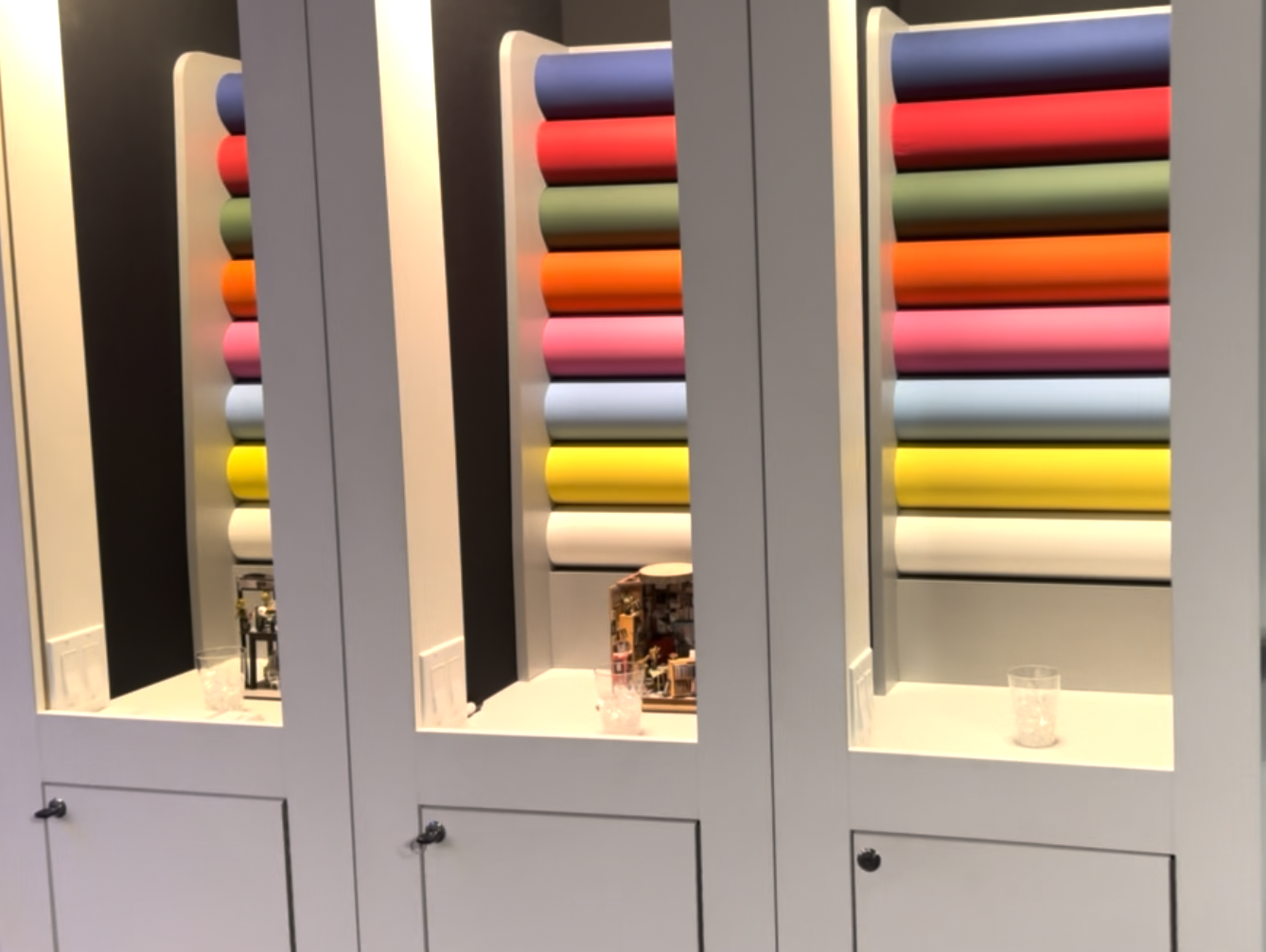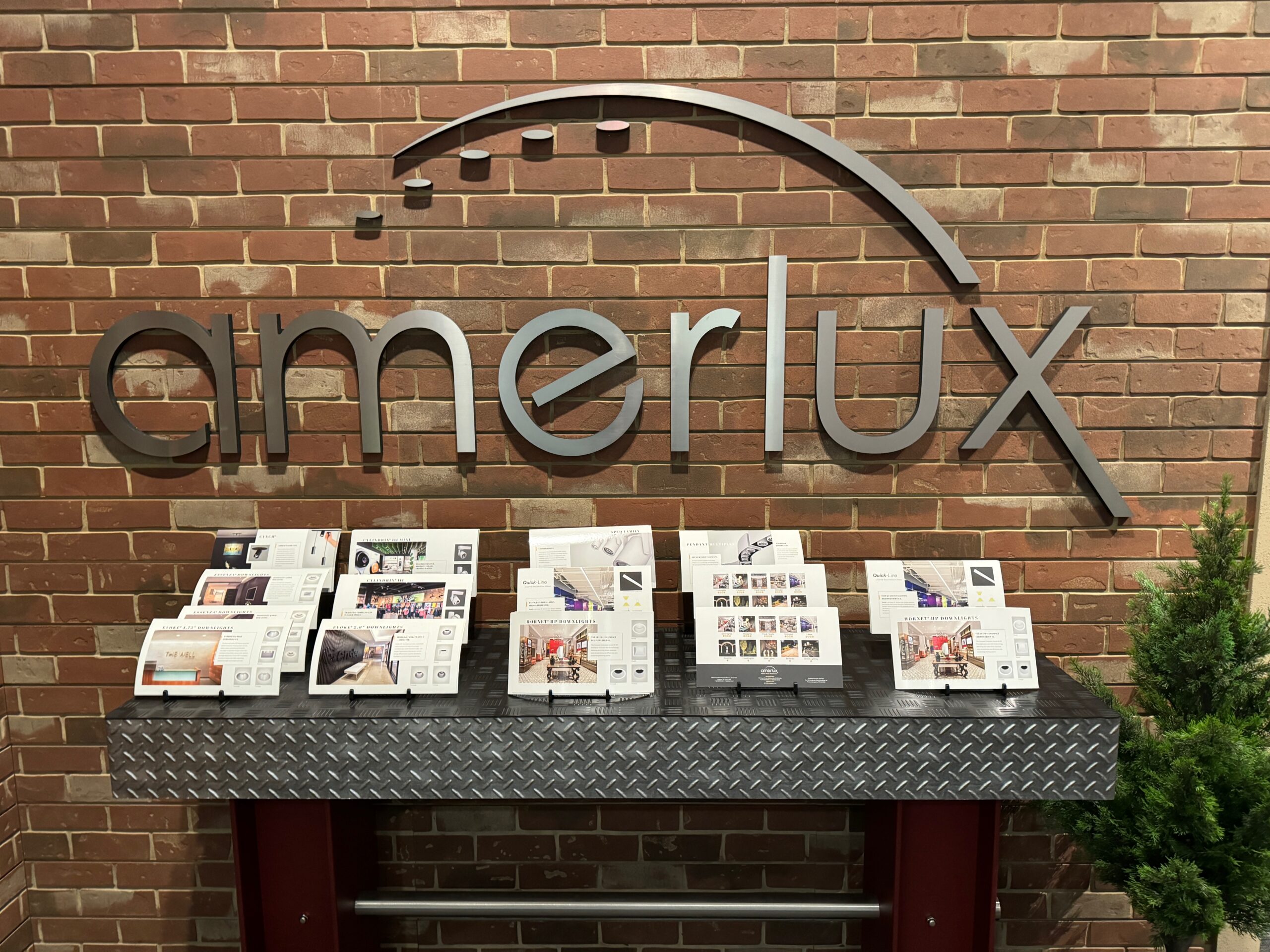During my visit to Amerlux last month, the liberty granted to your humble editor was unparalleled—I roamed freely, engaged with any of the staff, and delved into topics of my choosing. My host, Bill Plageman, VP of Marketing & Product Management, facilitated an unscripted session with CEO Chuck Campagna, enriching my understanding of their journey from “supermarket lighting specialists” to leaders in LED innovation.
Their founding principle, “never miss an opening for a supermarket,” speaks volumes about their commitment to the sector.
See the first portion of that discussion here.
Amerlux has carved a unique path. Their story begins not in sleek design studios or trendy showrooms, but in the aisles of American supermarkets. Their early motto, “Never miss an opening for a supermarket,” perfectly captured their dedication to this niche market.
In the wake of the financial crisis of 2007/2008 and with the continuing tightening of energy codes, LED lighting emerged as a viable, energy-efficient alternative to traditional lighting sources such as fluorescent lighting and provided more design flexibility.
Amerlux seized the opportunity to redefine its business and entered the commercial market with a designer-focused range of small-scale downlight and linear solutions. Today, Amerlux is the leading manufacturer of commercial lighting solutions used throughout the country and in many office build-outs in New York City, the largest market in the United States, which has the most discerning architects, lighting designers, and contractors.
Amerlux proudly manufactures and assembles all of their products in the U.S. at its 200,000-square-foot office and manufacturing facility in Oakland, NJ.

A few decades ago, Amerlux embraced metal halide technology, recognizing its potential for improved color quality and lamp life. This commitment to cutting-edge solutions was furthered by the arrival of Chuck Campagna, who saw the potential of Amerlux’s expertise beyond grocery stores. Under his leadership, Amerlux expanded its reach to the broader retail arena, championing a “one lamp” concept that simplified maintenance and streamlined operations for store owners.
As the 2000s dawned, the landscape of lighting shifted dramatically. Unlike many competitors scrambling to adapt existing fixtures to LED, Amerlux took a bold step – they started from scratch.
They designed and built entirely new fixtures dedicated to the unique demands of LED, a testament to their unwavering commitment to innovation. This forward-thinking approach paid off handsomely as Amerlux became one of the first manufacturers to bring LED lighting to supermarkets in 2005. This pioneering move showcased the potential of LED for superior white light, reduced heat emission, and extended lamp life, benefits eagerly embraced by supermarkets.
Recognizing the growing demand from architects and lighting designers, they ventured into the realm of architectural lighting, developing an array of LED downlights and linear fixtures. This commitment to the evolving needs of the industry further solidified Amerlux’s position as a leader.
Eco-Driven Expansion: Amerlux Under Delta’s Wing
Joe Manning, Vice President Engineering and Business Development, commented on the impact of being acquired in 2019 by Delta Electronics—one of the world’s largest electronics companies. Delta’s environmental stewardship emphasizes the company’s active role in promoting sustainability through initiatives like their net-zero U.S. headquarters in Northern California. This facility showcases its dedication to eco-friendly practices, including the use of subterranean heat pumps for efficient temperature control and public displays of energy consumption metrics.
“We’ve always been committed to pushing the envelope when it comes to sustainability,” says Manning. He describes Amerlux’s initiative of installing a substantial solar field atop their factory as part of their effort to align with Delta’s environmental objectives, potentially allowing them to contribute excess energy to the power grid.
Joe pointed out that Amerlux’s strategy goes beyond just solar installations. “Our approach is holistic, integrating advances like battery storage and smart lighting systems to reduce our energy footprint substantially.”
Delta’s broader vision encompasses building automation, consolidating disparate systems such as HVAC, access control, and surveillance into a unified operation. “The end goal,” Joe states, “is to create a seamless ecosystem within our buildings, making them as intelligent and efficient as possible.”
Cleaning up the Acne
Bill Plageman explained Delta’s role in Amerlux’s holistic approach which involves integrating other technologies offered by the parent Delta into lighting solutions, ensuring a seamless operation within building automation systems. Bill said, “This strategy is particularly relevant in dynamic cities like New York, where office spaces are being repurposed into residential apartments, necessitating versatile control systems capable of managing individual rooms, entire floors, or buildings as cohesive units.”
The systems designed are comprehensive, encompassing HVAC, security cameras, lighting, access controls, and even environmental factors such as humidity and sunlight exposure, all synchronized to function in harmony. Delta’s extensive reach in electronics, from power supplies in personal gadgets to EV charging stations, enables the integration of advanced technology into lighting fixtures, which Bill refers to as “cleaning up ceiling acne.”
He highlighted the importance of early involvement in architectural projects to ensure that lighting and control systems are not an afterthought but a fundamental design component. This proactive engagement aims to unify the various systems within a building from the outset.
Operational Efficiency: Inside Amerlux’s Process
My day at Amerlux included a full tour beginning in Customer Service. Dana Mazzetta, a customer service representative, detailed the order entry process, noting that they can provide estimated shipping dates within a day. Mazzetta personally sets the estimated ship date, drawing from production team insights, with a typical window of two to six weeks for order fulfillment, although this can fluctuate with product specifics.
The commercial, educational, and institutional markets present significant challenges with custom demands and made to measure linear runs/ patterns, human-centric lighting, and smart fixtures, etc. Some companies that rely on importing finished products from overseas struggle to keep up with Amerlux’s capabilities.
Amerlux has implemented a configurator, a critical innovation for refining project drawings and cost estimations. With its online functionality, sales representatives can produce precise drawings and quotations, significantly reducing redundant workloads for engineers and accelerating the order process. The configurator comes into play by deferring the need for formal drawings until an order is confirmed and approved, thus maintaining an efficient and precise workflow from inception to completion.

Collaborative Hub: Engineering Communication and Innovation
Next on the tour was a collaborative workspace. The office layout optimizes the proximity of customer service, engineering, purchasing, and quotes, allowing for quick and easy multidisciplinary team gatherings. “This proximity enables teams to congregate in the central collaboration area, discuss projects collectively, and return to their desks without the loss of time or momentum,” Bill notes. The area fosters spontaneous idea-sharing, enhanced by whiteboards integrated into the walls and ceilings.
Amerlux’s agile response to custom requests is a byproduct of its flat organizational structure, which streamlines communication and expedites decision-making. Sales staff can directly interface with engineering teams to discuss potential product variants or customizations. Bill guarantees, “Whether a client needs a slight tweak or a unique solution for a major project, we commit to delivering a definitive response within 24 hours.” Their self-sufficiency and extensive catalog of non-standard solutions minimize the need for outside dependencies and accelerate the response process, ensuring that architects and lighting designers receive the timely support necessary to keep their projects moving forward.
Production and Agility: Adapting to Challenges
Next on the tour was the factory floor. Mike Harris is the production training manager, who has over a decade of experience with Amerlux. He detailed his journey from starting as a powder coat painter to climbing the ranks to his current role, illustrating the opportunities for growth within the company. With a workforce fluctuating between 135 to 160 on the operational side, Mike oversees the production of 1200 to 1500 fixtures daily, a testament to the company’s robust made-to-order business model.

Mike also explained the decision-making process behind production schedules, emphasizing reliance on capacity, ship dates, and parts availability. He takes pride in the team’s ability to adapt to changing demands and unexpected requests, such as those from Bill, who might need to prioritize a show or a customer sample. Their proactive approach—planning capacity a week ahead and staying agile—allows them to handle curveballs efficiently. This nimbleness in production is key to maintaining their commitment to quality and timely delivery.
Problems on the Factory Floor
As a reporter, it’s not every day that you’re caught off guard by the candor of corporate operations. However, my interaction with Donnie Knickerbocker, director of Operations, was refreshingly transparent. He openly discussed the nitty-gritty of a real-time operational hiccup —a snag in the Oracle ERP system that failed to generate work orders for four days straight. Instead of glossing over the issue, Donnie was forthright about the glitch that thrust the team into a manual scramble to keep production on track. He detailed measures such as reworking staff schedules and rallying material handlers to pull extra hours, all to ensure their shipping commitments stood firm. It’s a rarity to encounter such frankness about in-the-moment challenges, and Donnie’s openness was an unexpected affirmation of our agreement: the unvarnished truth was on the table, no questions off-limits.
The Showroom Experience: Displaying Amerlux’s Versatility
Next up was the 7,000-square-foot showroom and training facility, which serves as an immersive experience for lighting designers. , “Unlike our competitors who may specialize in one aspect of lighting, Amerlux offers a comprehensive portfolio, positioning itself as a ‘mini conglomerate’ that remains approachable and customer-focused,” commented Bill.

The evolution and innovation within Amerlux is highlighted by the dynamic nature of their product lineup which is too diverse to be displayed in their showroom. The journey began in 1984 as a track lighting manufacturer, known for their robust “ruggedly handsome fixtures” by Amerlux. Over time, the fixtures shrank in size, as the metal halide lamps shrank from the ED 17 to T6 then to T4, and finally to the mini mastercolor. Around 2007/2008, amidst economic downturns, the company ventured into LED technology, with its first LED product marking a shift from its traditional supermarket lighting focus.

Bill recounted challenges faced in creating LED fixtures that supermarkets would accept, given the inherent color shift issues and the industry’s interest in shapes other than round track accents— a rare form in LED design due to the novelty of the binning process and that all LED die were round at the time. They navigated these challenges by adopting chip-on-board technology, which allowed for smaller sizes, better color control, and better overall management of the lighting elements.
Innovation on Display: Amerlux’s Product Evolution
The Amerlux Quintetta luminaire, now discontinued, emerged from a collaborative effort during the nascent phase of LED technology in 2010-2011. It was developed with input from a New York designer to serve as a substitute for traditional linear fluorescent fixtures, targeting clients who were familiar with and preferred fluorescent lighting but were skeptical of transitioning to LED technology. Addressing this hesitation, Amerlux developed Quintetta—an LED fixture designed with five illuminated sides to emulate the classic look of a fluorescent tube, including darkened ends that replicate the appearance of socket caps. This innovative design offers a familiar aesthetic while being fully LED-powered.
Quintetta was pioneering for its time, eschewing the need for a power cord, a novel feature when LEDs were first gaining traction. Although the concept didn’t immediately catch on due to its unconventional look and market LED hesitancy, it served a client’s desire to maintain a fluorescent-like aesthetic while transitioning to LED technology.
An interesting anecdote is about their interaction with a New York lighting design firm that sought an innovative solution to the cumbersome fluorescent strips placed atop office credenzas, which collected dust and broke easily. The firm proposed utilizing the slim profile and shallow LED solution to embed them in walls, offering indirect lighting without clutter and maintenance headaches. This idea was not just a theory; it was materialized into a product that Bill proudly utilizes in his own office.
The resulting design — a wall-mounted LED fixture — has found its niche, particularly in the healthcare sector, where it offers a softer, indirect light source that enhances the patient experience and meets stringent hygiene standards. This luminaire, the FINO, circumvents the harshness of traditional two-by-four ceiling fixtures and contributes to a more comfortable environment for patients and staff, boasting an impressive sales record as it caters to specific needs of the healthcare industry.
Bill demonstrated the functionality of Delta Electronics’ O3 Sensor within a modern, automated office environment. This sensor revolutionizes climate control by adjusting the lighting to support human circadian rhythms, transitioning from a cool 5500K to a warmer 2700K, and regulating which fixtures are on or off. Beyond lighting, it measures humidity and temperature at crucial points like desk level, rather than less representative locations such as ceiling/ wall. This precision negates the need for traditional thermostats, leading to significant cost savings in material, wiring, and installation.
Adjustments to the environment are made via a tablet/display or wall switch, though interaction is generally discouraged to maintain consistent temperatures throughout the space, accounting for variations such as proximity to windows. The O3 sensor also enhances security and efficiency by detecting occupancy, controlling window blinds, and potentially integrating facial recognition with the addition of a camera. This system represents a shift towards a more intuitive and cost-effective method of building management.
The Aerus light fixture is designed to redefine comfort and compliance with the WELL Building Standard’s Unified Glare Rating (UGR). Its innovative design allows for fewer fixtures within open spaces, achieving a more comfortable working environment. Unlike typical indirect/direct fixtures, Aerus can be mounted just 12 inches below the ceiling, rather than the standard 18 inches, making it suitable for spaces with lower ceilings. Aerus is designed to deliver the recommended lighting levels as recommended by IES, with fewer fixtures. The lighting solution features direct-indirect distribution and is housed in a slim 7/8” high body that eliminates the harsh brightness from direct distribution and softens the amount of light directly above the fixture. Aerus delivers a comfortable work environment that enhances productivity. Its slim design with the absence of an exposed power cord provides an unobtrusive aesthetic and comfortable work environment.
The Finch luminaire stands out in Amerlux’s lineup for its exceptional versatility, much like the agile bird it’s named for. Finch is the first complete family of 1” aperture downlights offered in recessed, surface cylinders, inground stake or wall, and window mullion mounts for both interior and exterior applications. It’s performance and quality optical control brings upscale sophistication to any design.
Bill further notes, “Lighting is the unsung hero in retail environments, bringing products to life.” At Amerlux, they harness the nuances of color and intensity to elevate retail settings into dynamic showcases, making products the focal point. The targeted lighting on display mannequins immediately draws the eye, setting them apart from their surroundings. This approach deliberately bypasses broad lighting schemes for precise point sources, offering fixtures from recessed to wall washing, adjustable to semi-recessed, with track heads and downlights — each designed to curate an experience where the merchandise, lighted just right, becomes the undeniable center of attention.
Supermarkets prioritize efficiency but are also heavily invested in product appeal. Amerlux navigates this by offering lighting that not only meets an 80 Color Rendering Index (CRI) standard for efficiency but also a 90 CRI for superior color quality. With their close relationship with Rensselaer University experts Jean Paul Freyssinier and Nadarajah Narendran, Amerlux offers the Class A chip—a full gamut chip that enhances color fidelity, particularly beneficial for items like flowers, which are among the most profitable in supermarkets. It not only improves appearance but also suggests longevity.
This full gamut technology offers a spectrum of light that makes colors pop, especially reds and whites. Supermarkets have widely adopted the Class A chip, recognizing its impact on sales, particularly in high-profit areas such as floral, produce, bakery, and meat and fish. A curious anecdote Bill recalls is this impact: “While mapping out a supermarket upgrade, we encountered a customer who perceived the produce as superior in the same company supermarket a few miles away. In reality, the produce was identical in quality. The only difference was the lighting.”
The clarity of a fish’s eye, a common indicator of freshness, can now be accentuated through lighting. The Class A chip’s superior Color saturation ability ensures that the subtle details, such as the lucidity in the eyes of the fish and the eye-catching color of tomatoes are more discernible, signaling freshness all through the shopper’s eyes.
The benefits of the Class A chip extend beyond seafood and produce. The marbling of meat—a quality indicator for steak—becomes more pronounced, showcasing the texture and quality that customers seek. And it’s not just organic products that see an improvement; inorganic materials like ice, used to present and preserve perishables, appear cleaner and more sparkling white. This enhancement in appearance leads customers to associate the freshness of the ice with the freshness of the products, creating a cleaner, more premium offering.
Lighting plays a critical role in retail, particularly in the world of fashion where it can make or break product appeal. While a certain type of light may cast a wedding dress in a stunning, almost ethereal glow, enhancing the intricate details and fabric, the same light can be unflattering when it comes to illuminating skin tones. The distinction between product display and the customer experience in the dressing room is crucial. A light that showcases the garments at their best may not do justice to the complexion of the customer. A dressing room demands a high Color Rendering Index (CRI) to ensure skin tones look natural and appealing. If the customer doesn’t like the reflection in the mirror, chances are the dress will be left behind.
The Amerlux story is one of persistent innovation and adaptability. From pioneering in supermarket lighting to embracing LED technology, Amerlux has consistently led the charge in transforming spaces with light. Their commitment to sustainability, their cutting-edge product designs, and their integrated approach to building operations embody a mindset that’s not just about illuminating spaces but enhancing experiences.
Amerlux strives for lasting relationships with all stakeholders, including architects, lighting designers, facility managers, and contractors. They listen to their customer’s goals and challenges and offer a range of superior, high-end lighting solutions backed by robust warranties, substantial cost savings, and unparalleled service. . All while meeting the most demanding lead-time requirements.
Stay tuned for the continuation of our exploration into Amerlux’s bright journey and watch the second half of my interview with CEO Chuck Campagna on 29 January 2023.




